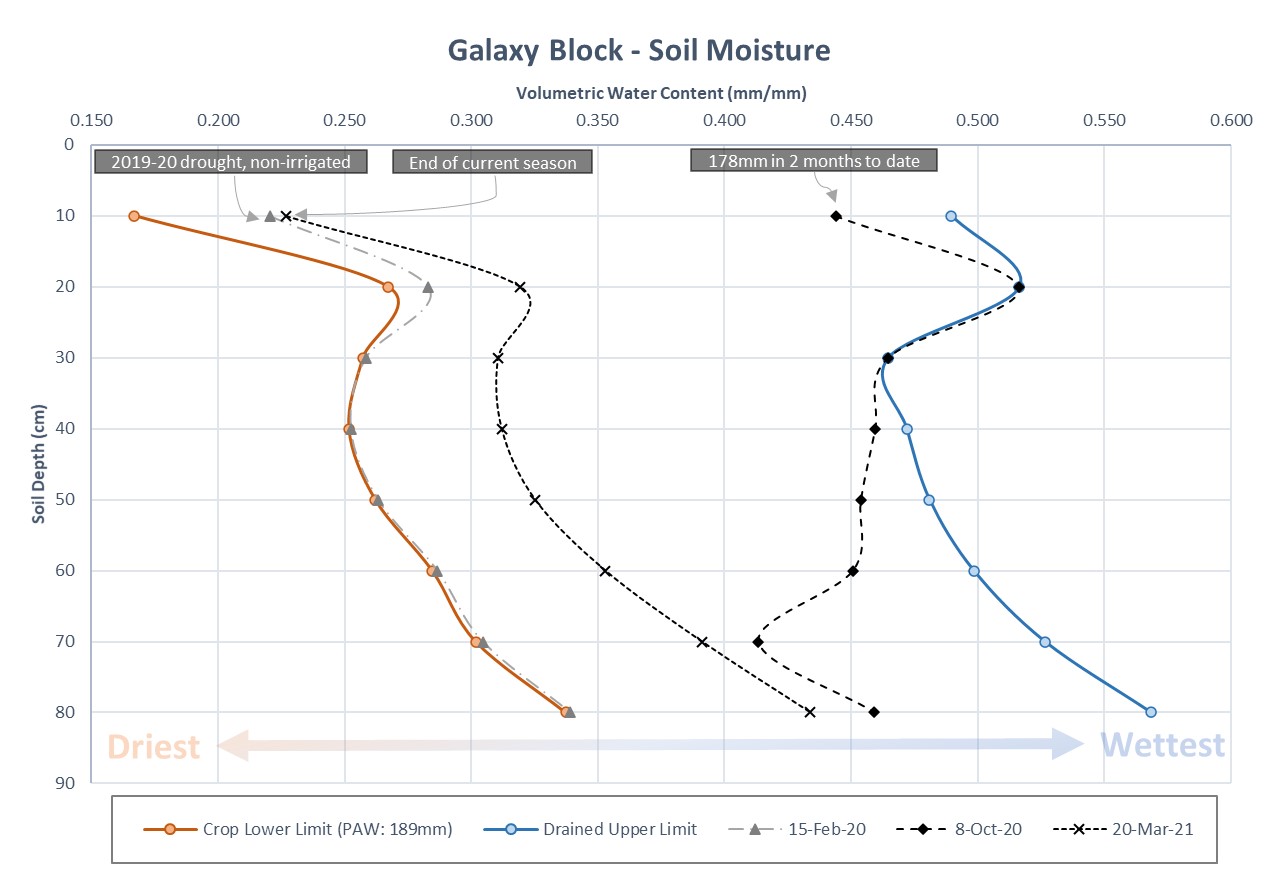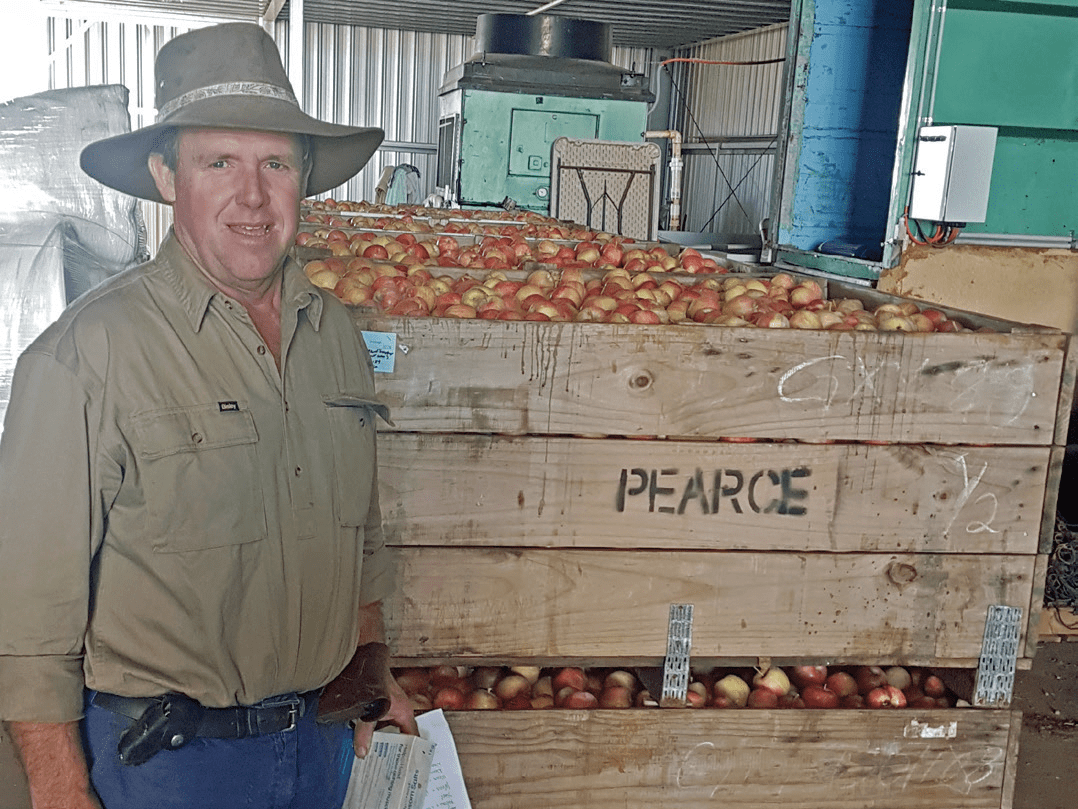The hot, catastrophic summer of 2019-2020 followed an extended dry period for much of NSW. For the state’s horticultural growers, that combination reduced water storage across many orchards.
For Ian Pearce, who grows apples and cherries near Orange, it meant making tough decisions on which blocks to focus efforts, and which to sacrifice and leave unwatered.
However, in the space of just a year, the way these types of difficult decisions are made is being turned around through the adoption of on-farm digital technology.
Ian is partnering with NSW DPI in its Climate-smart Horticulture Pilot, part of the broader $6.7 million Climate Smart Pilots project. The Horticulture Pilot aims to increase resilience to climate change by improving the understanding and use of digital agriculture technologies.
By partnering with Ian, NSW DPI is demonstrating how implementing digital agriculture technologies within a commercial operation can improve climate resilience through adaptive management decisions that provide yield, quality and productivity benefits.
Technologies Tested
Already one digital agriculture technology, soil moisture monitors, is making a difference.

Temperate Fruits and Horticulture development officer Jessica Fearnley, who is advising the Horticulture Pilot and leading its implementation, says soil moisture monitoring provides essential information for good irrigation management.
“This results in better control over water inputs, better yields and increased profitability.”
At Ian’s 18-hectare orchard, better data on soil moisture trends has already changed how irrigation is managed.
Although it is commonly acknowledged in the industry that drip irrigation is more efficient than other irrigation methods, easy access to irrigation data showed just how dramatic that difference was.
Soil moisture sensors revealed that drip irrigation provided improved water efficiency compared to traditional surface sprayers, data that very quickly motivated Ian to change Stoneleigh’s irrigation to a complete drip system.
Ian says that if he had this information earlier, the 2019-2020 season would have been completely different.
“It would have motivated me to make the change earlier, and perhaps it would have saved some of the areas sacrificed.”

Although happy with the short-term benefits of soil moisture monitoring, there are also longer-term benefits associated with this digital technology.
Miss Fearnley says that water security is vital to horticultural operations.
“Water has always been a closely monitored resource as licences and infrastructure require high capital outlay. With additional scrutiny on water extraction and the rising electricity costs associated with pumping, there is increasing pressure to optimise water use efficiency and minimise power use. This means closer monitoring of water resources is essential and the new digital tools being trialled provide an accessible way of doing this.”
Other technologies being tested at Stoneleigh will bring a mix of both short and long-term benefits.
An automatic, on-site weather station measures local conditions providing greater relevance compared with regional weather sites. The solid-state machine measures 12 weather variables, including air temperature, relative humidity, vapour and barometric pressure, wind velocity and direction, solar radiation, precipitation, and lightning strikes.
It provides real-time weather data for record keeping, but also offers farm-specific forecasting opportunities. This data can be used for planning spray activities, irrigation scheduling, and chill portion calculations.
Photosynthetically active radiation (PAR) sensors, both above the canopy and at ground level, estimate the amount of light intercepted by the canopy. By giving an indication of canopy size, this tool can help measure tree growth and health.
Mounted within the canopy, are temperature and humidity sensors to help predict conditions that favour disease and infection. These sensors can help trigger management decisions, such as preventative or controlling sprays or how extensively to prune.
To help monitor farm resources, depth and temperature sensors are being trialled in chemical and fuel tanks. For water accounting, flow sensors will measure how much water is being pumped, while wireless irrigation valve controllers that allow irrigation schedules to be automated will be tested. They can improve water use efficiency gains, reduce labour and add convenience.
Dashboard
All the data produced by the technologies are easily accessed through the NSW DPI FarmDecisionTECH website.
The dashboard shows current conditions for each sensor, represented by a widget, an easy to read graph, table of values or slider. Historical data can also be downloaded to allow additional analysis. Notifications and alerts can be setup for any device.
Economic Improvement
Miss Fearnley says the pilot comes at an important time for the horticulture industry, Australia’s second largest rural production industry worth $2.2 billion annually.
“Not only have years of dry seasons effected irrigation capacity, but technology to monitor a range of on-farm inputs has evolved and can lead to improvements in yield, quality and productivity."
“Horticulture is a high value, high input industry. Digital technology can monitor, predict and automate some decisions, reducing input and labour costs leading to economic and environmental sustainability improvements.”
Dr Allen Benter, who leads NSW DPI’s Climate Smart Pilots project, says the aim is to improve the horticultural industry’s knowledge of this technology and associated decision-making tools.
“There are technologies and tools available that can help the industry adapt to climate change. So, we want to overcome any barriers to adoption and reduce confusion among growers."
“By making sure the data gathered and used at our Stoneleigh pilot is available to all, we can show others in the industry how the technologies and tools tested there can be used to make better, more informed decisions elsewhere and ensure the industry is in the best place to adapt to a changing climate.”
Field days, both on farm and virtually will be held over the course of the four-year pilot.